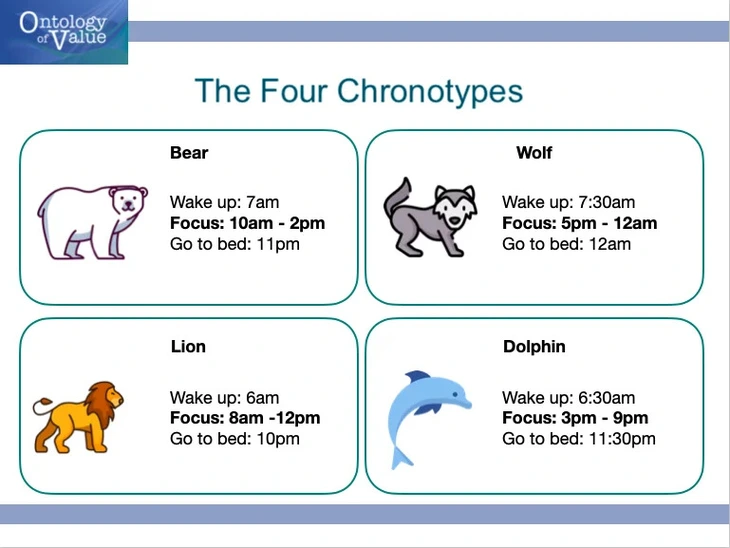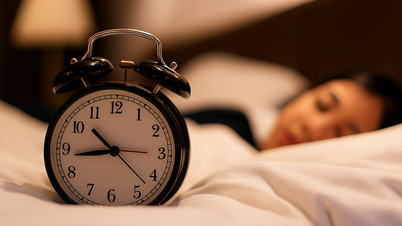
Chronotype determines sleep and exercise time zones - Photo: PT
Lions, bears, wolves and dolphins
Chronotype was originally a concept in the field of sleep science , before gradually being taken seriously in scheduling and planning physical exercise for each person.
Chronotype is understood as the natural tendency that makes a person tend to be more productive at certain times of the day.
This concept was developed by physiologists in the 1970s, through scales such as the Morningness–Eveningness Questionnaire (MEQ) or the Munich Chronotype Questionnaire (MCTQ).
Chronotypes were originally divided into three groups: “morning people”, “evening people” and “neutral”. Later, American clinical psychologist Michael Breus divided them into four groups, popularized as four animal symbols in the book The Power of When (2016).
According to him, we can tentatively call these chronotypes lion, bear, wolf and dolphin.
Leos are the archetype of early risers, usually waking up between 5am and 6am and reaching their energy peak between 7am and 11am.
They often work out best in the morning, when cortisol and testosterone are both high, helping the body stay alert and muscles react quickly.
However, "lions" also get tired easily and often go to bed before 10pm, so late night workouts will be less effective.

Chronotype classification table - Photo: TA
Bears are the most numerous group, making up about half the population. Their circadian rhythm closely matches the solar cycle: they rise when it's light and fall asleep when it's dark.
People in this group are usually at their best physical condition between 10am–2pm, which is suitable for mid-day or early afternoon workouts.
Because they follow the “biological crowd,” bears easily adapt to regular school and work schedules as well as daytime sports tournaments.
Wolves are true “night owls.” They have trouble waking up early and stay lethargic until midday.
Wolves' energy peak typically falls between 5pm and 11pm. Research in the journal Applied Physiology (2020) shows that muscle strength and exercise capacity of this group can be 5–10% higher in the evening than in the morning.
That explains why many basketball, soccer or martial arts athletes - who often compete at night - belong to the "wolf" group.
Dolphins are a special group, representing people who have trouble sleeping or have light sleep. Like real-life dolphins who only sleep half their brains to stay alert, this group tends to sleep fitfully, wakes up easily, and rarely feels full of energy.
Their most effective training time is usually between 10am and 2pm, when their brains and bodies are at their most stable. However, dolphins need to pay special attention to the quality of their sleep if they want to maintain their long-term athletic performance.
Chronotype is not an arbitrary choice, but is formed through biological development.
Children are often “morning people,” who tend to go to bed early and wake up early. By adolescence, their biological clocks shift again, causing most high school and college students to become “evening people,” who have trouble falling asleep early and are more alert in the late afternoon.
Research from the University of Munich (Roenneberg, 2007) shows that this “night owl” activity peaks around 17–20 years of age.
After the age of 25, chronotype stabilizes and becomes a relatively stable characteristic of each person. As we age, the biological rhythm gradually shifts towards the morning, causing older people to often wake up early and feel sleepy from the evening.
Should I try to change my chronotype?
So how do you know which group you belong to? Aside from scientific questionnaires, the simplest way is to observe yourself when you are not tied to an alarm clock or work.
Let your body decide when to wake up and when to sleep, and note down when you feel most alert and energetic. If you are energetic in the morning, you are probably a lion.
If you’re best in the evening, you might be a wolf. If you settle into a routine easily, you’re more of a bear. If you struggle with sleep, waking up frequently during the night, you might be a dolphin.

Each person has their own suitable biological rhythm - Photo: ARU
It's important not to try to fight your chronotype. Sleep scientists recommend aligning your exercise and work routines with your natural circadian rhythms for maximum effectiveness.
If you're a lion, work out in the morning to take advantage of your hormones and alertness. If you're a bear, a midday or early afternoon workout schedule is more appropriate.
For wolves, don’t force yourself to get up at 5am to run, but instead exercise in the evening – as long as it’s not too close to bedtime. For dolphins, the most important advice is to improve the quality of your sleep, and choose the middle of the day when your body is at its most restful.
Chronotype is a combination of genetics, hormones, and environment. Understanding your chronotype will help you create a reasonable exercise schedule that maximizes your energy and saves time.
Source: https://tuoitre.vn/tu-nhan-biet-kieu-thoi-gian-biology-de-chon-thoi-diem-nen-tap-the-thao-trong-ngay-20250828204606479.htm


![[Photo] Prime Minister Pham Minh Chinh attends the opening of the 47th ASEAN Summit](https://vphoto.vietnam.vn/thumb/1200x675/vietnam/resource/IMAGE/2025/10/26/1761452925332_c2a-jpg.webp)
![[Photo] Nhan Dan Newspaper displays and solicits comments on the Draft Documents of the 14th National Party Congress](https://vphoto.vietnam.vn/thumb/1200x675/vietnam/resource/IMAGE/2025/10/26/1761470328996_ndo_br_bao-long-171-8916-jpg.webp)


![[Photo] Enjoy the Liuyang Fireworks Festival in Hunan, China](https://vphoto.vietnam.vn/thumb/1200x675/vietnam/resource/IMAGE/2025/10/26/1761463428882_ndo_br_02-1-my-1-jpg.webp)
![[Photo] General Secretary To Lam received the delegation attending the international conference on Vietnam studies](https://vphoto.vietnam.vn/thumb/1200x675/vietnam/resource/IMAGE/2025/10/26/1761456527874_a1-bnd-5260-7947-jpg.webp)







































































































Comment (0)